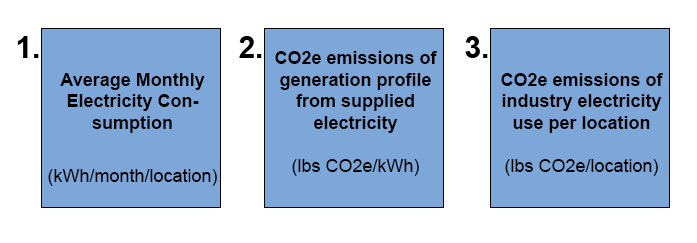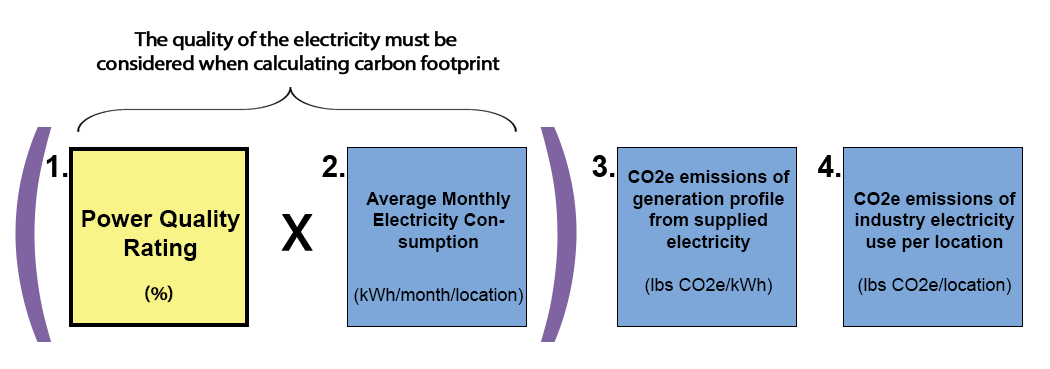
Fossil fuel generation of electricity is directly related to global greenhouse gas (GHG) emissions and regardless of the regional differences in power generation profiles, a substantial portion of the electricity supplied to facilities worldwide is generated from some fossil fuel source.
On the other end is the consumption of electricity. Nothing about consumption is linear or predictable. Electricity is a tricky thing to measure because power flow occurs in Real-Time. How to you accurately measure something flowing at the speed of lightning?
There is a desire for a one to one equation that directly links carbon footprint to electricity consumption because electrification is directly responsible for nearly all of the global CO2 pollution. There has yet to be one because of the complicated reality of electricity. The main complication is in electrical energy loss.
Electrical energy loss is completely unpredictable, non-linear and occurs in Real-Time, however when it occurs, that energy is wasted and gone forever. So the power that flows from the plant through the distribution system to a facility can be lost on site, wasted as heat or vibration in the power network. That energy took up capacity all the way costing stakeholders money, to the point of being lost at which point it contributes to wear and tear of the electronics or infrastructure; absolutely no useful life.
In reality, the contribution to CO2 emissions due to this type of waste is horrifying. We waste more that two times the electrical energy we generate in this way. By preventing electrical energy waste, there would be no need to add any more generation to the grid, the global CO2 emissions challenge could entirely be solved through efficiency.
Electricity Consumption and Calculating a Carbon Footprint
There is no uniform formula to calculate a carbon footprint from electricity. The typical carbon footprint Calculator includes some variation of combining the amount of electricity consumed, the average emissions released based on the regional power generation profile, and the average emissions released by the industry equivalent sites.
Typical Carbon Footprint from Electricity Calculation

This methodology does not take into account the quality of the electricity being consumed. If the efficiency of generation, distribution and consumption of electricity is low, there is an increase in energy consumed by electrical energy loss rather than energy consumed by loads. In other words, large amounts of the electricity is generated and subsequently lost as heat or vibration contributing only to the carbon footprint and added costs.
Power Quality Rating
Power Quality Rating (PQR) is a metric which represents the overall efficiency of the electrical power flow. The number is a multiplicative parameter that combines the 3 most common and harmful disturbances that reduce electrical network efficiency, reactive power, total harmonic distortion and imbalance across the phases. Lower efficiency comes with poor power quality and leads to higher costs, more frequent power disturbances, and an increase the wear and tear to the assets.

PQR is a dynamic metric that changes in response to the Real-Time power flow.
Including Power Quality Rating of Electricity When Calculating a Carbon Footprint

When the Power Quality Rating is considered in the calculation of a carbon footprint from electricity, it accounts for the variation in demand side power quality and supply side electrical service quality.
Perfect Power Quality Rating – Is it Possible?
Maintaining a nearly ideal Power Quality Rating is possible, however there is only one way to do it. Power flow must be controlled and balanced in Real-Time as it flows. Software-Defined Electricity (“SDE”) is embedded intelligence into the power network that optimizes the power flow in Real-Time as it flows.
By correcting for the three most common AC power distortions, reactive power, harmonic distortion and imbalance across phases, SDE maintains the PQR at a reliable 98%. Maintaining the highest possible Power Quality Rating delivers the highest possible efficiency in power flow.

Optimized power flow through embedded intelligence prevents almost all electrical energy loss in power networks creating clear transparency on the carbon footprint of electricity and delivering transformative change to an industry that requires it.
3DFS Software-Defined Electricity guarantees a near perfect Power Quality Rating ensuring the lowest possible carbon footprint no matter how the electricity is used.


